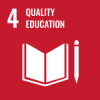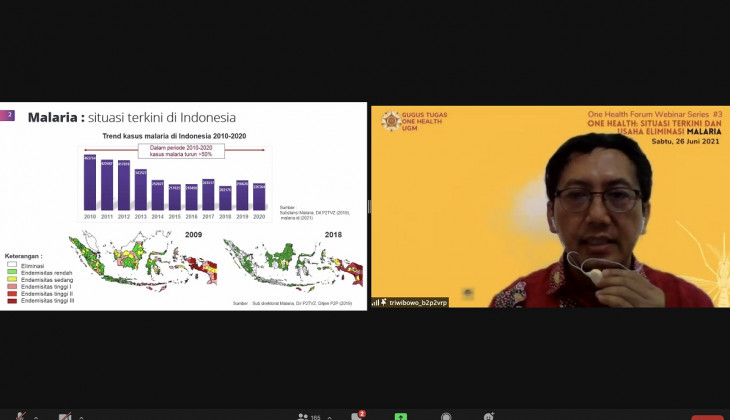Malaria is still a big problem in tropical and sub-tropical countries, including Indonesia. Although the Annual Parasite Incidence (API) in Indonesia has decreased in the last decade, this figure has been stagnant since 2014. With the Covid-19 pandemic, this number might increase if there is no new approach or intervention.
The One Health Task Force of FKKMK UGM discussed malaria in a seminar via zoom on Saturday (26/6). This seminar discussed three topics, namely the role and challenges of malaria vector control in supporting malaria elimination, the potential and dangers of malaria zoonoses, and the involvement of digital health innovators in malaria elimination.
Dr. Triwibowo Ambar Garjito of Center for Disease Vector and Reservoir Research and Development, Health Research and Development Agency, Indonesia, explained that the trend of malaria cases in Indonesia in the 2010 – 2020 period experienced a fairly good decline, which was more than 50%.
“In 2009, there were still many high endemic areas, but in 2018 several areas in Sumatra, Java and Bali had already received elimination certification. This is thanks to the efforts by the government,” he said.
Triwibowo explained that several efforts had been made by the government to significantly reduce the number of malaria cases in the last decade. For example, in areas with high endemicity, there is a wide-scale distribution and use of Long-Lasting Insecticide Treated Bednets (LLIN), application of Indoor Residual Spraying (IRS) in high-risk areas and outbreaks, as well as larva control and environmental management.
Meanwhile, in areas with low endemicity, increased case tracking, mapping of the focus of transmission, and active surveillance and case finding, and early diagnosis and prompt treatment (EDPT) were carried out.
Furthermore, Tribowo explained that the government set a new policy for island-based malaria elimination in Indonesia. Java, Bali will be the target of elimination in 2023, Sumatra, Sulawesi, NTB in 2025, Kalimantan, North Maluku in 2027, Maluku, NTT in 2028, and Papua and West Papua in 2029. Vector control and surveillance of malaria entomology are one of the 10 main dominants to achieve malaria elimination.
There are two priorities in malaria vector control. First, in areas of high transmission (Papua, West Papua, NTT, PPU Kaltim, NTT) and moderate transmission (Maluku, North Maluku, and Lampung). Second, in areas of low endemicity, but stagnant for more than five years, including West Java, Central Java, West Sumatra, Bangka Belitung, etc.
From the perspective of veterinary medicine, Dr. Wisnu Nurcahyo from FKH Universitas Gadjah Mada said that there are zoonotic diseases, namely diseases that are transmitted to humans and animals, including malaria.
“Diseases are transmitted from animals to humans, humans to animals, and so on. There are three actors, namely intermediate hosts such as snails, reservoirs such as rats, and vectors such as mosquitoes. Of the 1415 human pathogens, 868 (61%) are zoonotic,” he said.
According to Wisnu, there are several ways to overcome zoonotic malaria. There should be a common perception regarding the potential and threat of zoonotic malaria, capacity building for medical personnel, preventive efforts through education to the public, and collaboration and synergy of multi-stakeholders to overcome the dangers of zoonotic malaria.
Source: https://ugm.ac.id/id/berita/21301-situasi-terkini-dan-usaha-eliminasi-malaria-di-indonesia



